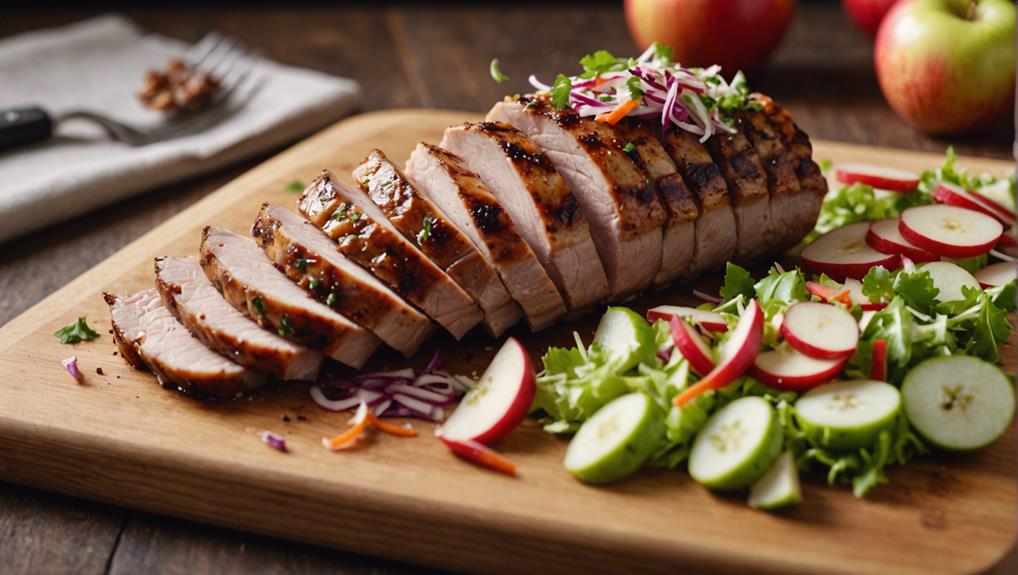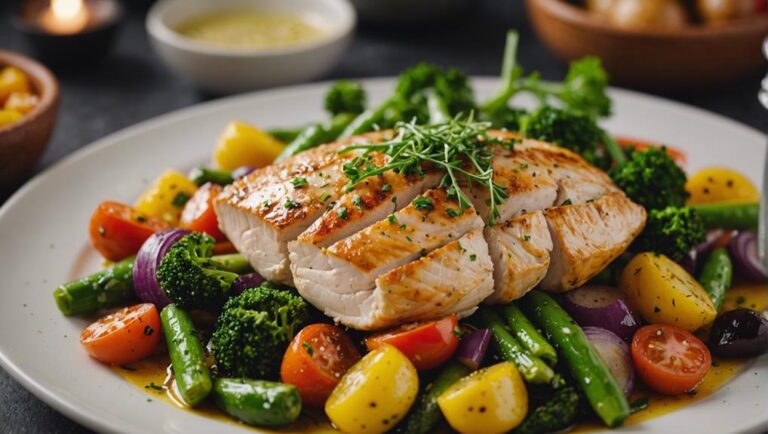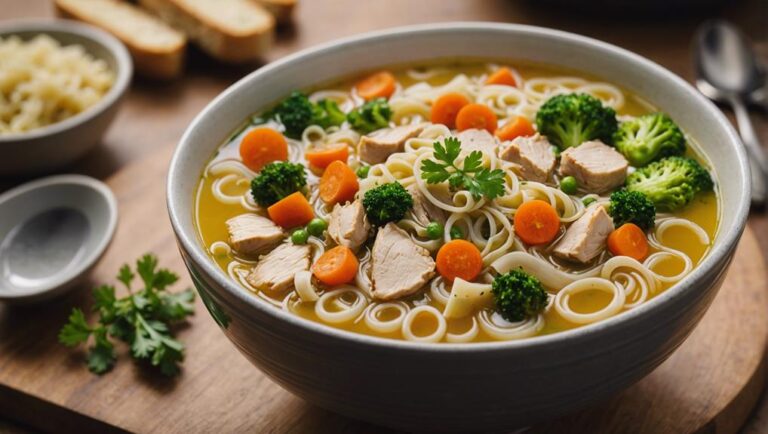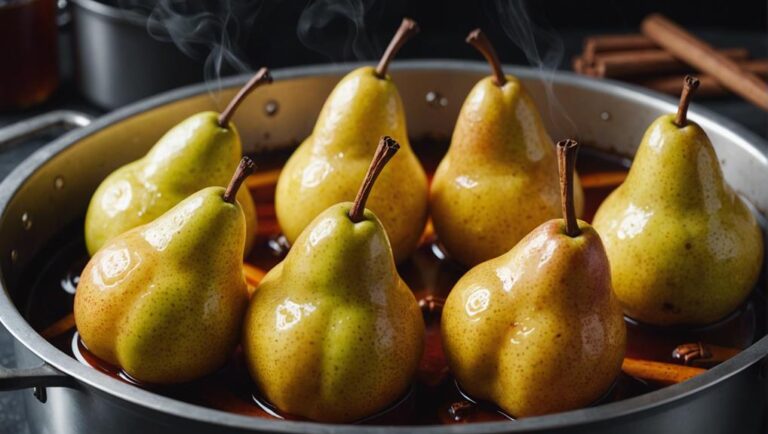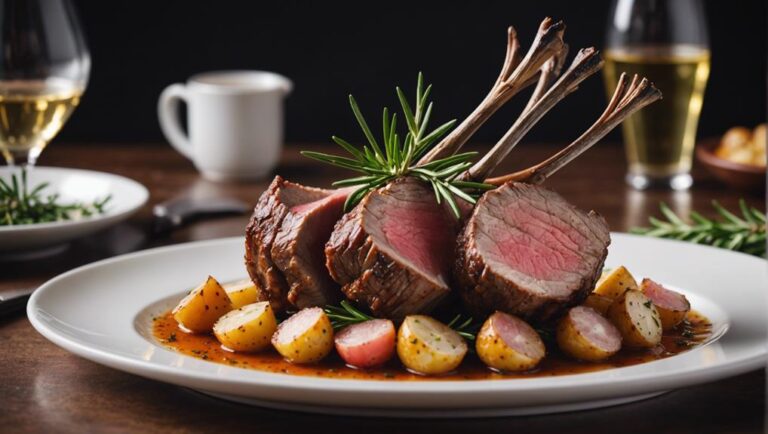Sous Vide Pork Tenderloin With Apple Slaw
Savor the succulent sous vide pork tenderloin paired with a zesty apple slaw. Achieve perfection in each tender bite with precise temperature control that French chefs like Georges Pralus honed. Enhance flavors using ingredients like smoky paprika, garlic, and a touch of citrus zest for a gourmet experience. Experiment with variations such as apple pork medley or apple cider glazed pork to elevate your dish. Finish with a caramelized sear to lock in juices and intensify flavors. Elevate your culinary journey with these techniques that promise a symphony of taste sensations.
What You Will Learn Here
- Sous vide pork tenderloin ensures precise cooking for optimal tenderness.
- Apple slaw provides a refreshing contrast to the rich pork flavors.
- Searing the pork post-sous vide adds a flavorful caramelized crust.
- Balancing savory pork with tangy apple slaw creates a harmonious dish.
- Experiment with sous vide temperatures for customized pork tenderness.
Sous Vide Pork Origins

Sous vide pork has a rich history that dates back to early experimentation with vacuum sealing and precise temperature control.
The evolution of sous vide techniques has been marked by advancements in technology and a deep understanding of meat preparation.
In modern culinary practices, sous vide pork is celebrated for its ability to deliver consistently tender and flavorful results.
Sous Vide Pork History
How did the technique of cooking meat in a precisely controlled water bath come to be associated with the tender and flavorful pork dishes we enjoy today?
The history of sous vide cooking dates back to the late 18th century when Sir Benjamin Thompson, an American-born British physicist, discovered the benefits of flavor retention and texture preservation through precise temperature control.
However, it wasn't until the 1960s that French chefs like Georges Pralus and Bruno Goussault further developed the sous vide method for culinary applications.
Their innovations in sous vide equipment and temperature control paved the way for the modern sous vide techniques we use today.
Through their dedication to precision and innovation, these pioneers laid the foundation for the exquisite pork dishes we savor in the present day.
Technique Evolution
The evolution of sous vide pork technique traces back to the innovative developments by French chefs in the 1960s, revolutionizing the culinary landscape with precise temperature control and flavor preservation methods.
These culinary advancements paved the way for the integration of evolutionary techniques that focus on enhancing the tenderness and juiciness of pork tenderloin through controlled cooking environments.
By vacuum-sealing the meat and immersing it in a precisely heated water bath for an extended period, chefs discovered a method that not only preserved the natural flavors and juices of the pork but also guaranteed consistent results every time.
This marked a significant shift in traditional cooking methods, showcasing how technology could be harnessed to elevate the dining experience through meticulous attention to detail and innovation in the kitchen.
Modern Culinary Applications
With advancements in culinary technology and a focus on precision, chefs have transformed the way pork tenderloin is prepared, elevating the dining experience through innovative cooking methods.
The domain of modern culinary applications has seen a surge in techniques like molecular gastronomy and fusion cuisine, where chefs push boundaries through culinary experimentation. Through molecular gastronomy, chefs harness scientific principles to deconstruct and reconstruct flavors, textures, and presentations, creating avant-garde dishes that surprise and delight diners.
Fusion cuisine, on the other hand, blends culinary traditions and ingredients from diverse cultures, resulting in unique and harmonious flavor profiles. These innovative techniques not only showcase the creativity and skill of chefs but also offer diners a truly unforgettable gastronomic experience that challenges traditional notions of cooking.
Pork Tenderloin Flavor Enhancers
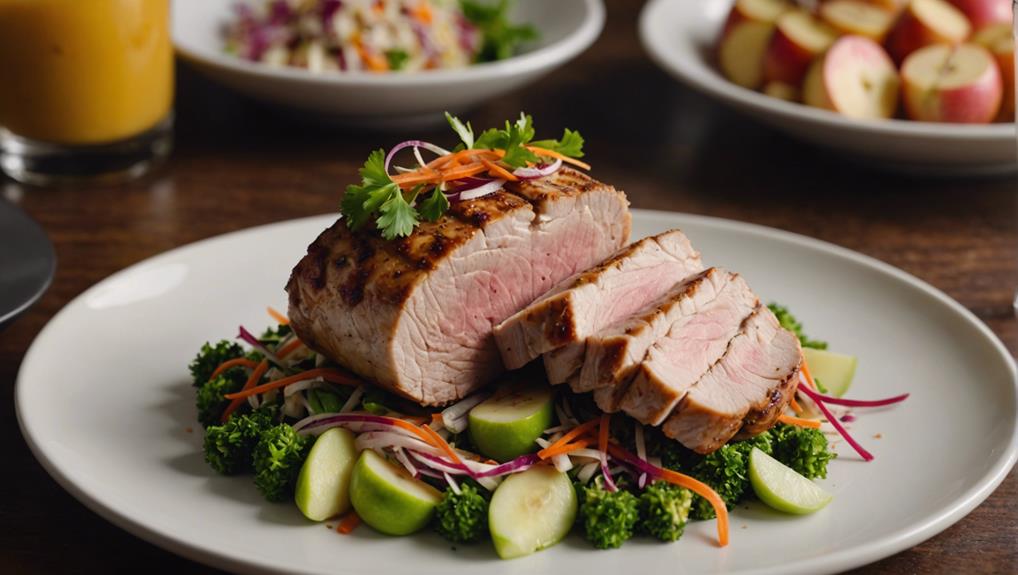
Consider incorporating a medley of herbs and spices to elevate the flavor profile of your pork tenderloin. The right combination can enhance the natural taste of the meat and create a harmonious balance that tantalizes the taste buds.
Experimenting with different flavor profiles and cooking methods can lead to exciting culinary discoveries. Here are some innovative ways to enhance the flavor of your pork tenderloin:
- Smoky Paprika: Add a touch of smoky paprika to infuse your pork tenderloin with a deep, earthy flavor that complements the meat's natural juiciness.
- Garlic and Rosemary: Create a classic blend of garlic and rosemary to bring out the savory notes of the pork while adding a hint of aromatic zest.
- Citrus Zest: Brighten up your pork tenderloin with citrus zest, such as lemon or orange, to impart an invigorating and tangy twist to each bite.
- Cumin and Coriander: Spice things up with a mix of cumin and coriander for a warm, fragrant flavor profile that adds depth and complexity to your dish.
These flavor enhancers can transform your pork tenderloin into a gourmet experience that delights the senses.
Tasty Pork Tenderloin Variations
You can elevate your pork tenderloin game with delectable variations like the savory apple pork medley, the sweet apple cider glazed pork, or the delightful apple pork tenderloin. These options offer a range of flavors that complement the pork's natural taste, creating a symphony of tastes that will delight your palate.
Experimenting with these variations can bring a new level of excitement to your pork tenderloin dishes.
Savory Apple Pork Medley
Indulge in the delightful combination of tender pork and crisp apples to create a mouthwatering savory medley that will tantalize your taste buds. When exploring pork medley creativity, incorporating apples can elevate flavors to new heights. Here are some innovative ways to enjoy a savory apple pork medley:
- Apple Pork Stir-Fry: Combine juicy pork strips with sautéed apples, bell peppers, and a hint of ginger for a fusion of sweet and savory flavors.
- Apple Stuffed Pork Chops: Impress your guests by filling succulent pork chops with a savory apple and herb stuffing, creating a delicious contrast of textures.
- Apple Pork Sliders: Mini buns filled with tender pulled pork mixed with a tangy apple slaw, offering a delightful blend of textures and tastes.
- Apple Pork Curry: Add apple chunks to a rich pork curry for a unique twist on traditional flavors, creating a harmonious balance between sweet and spicy notes.
Apple Cider Glazed Pork
Elevate your pork tenderloin game with a luscious apple cider glaze that adds a tantalizing twist to this classic dish. When preparing your apple cider-glazed pork, consider these key points:
- Apple Cider Pairing: Opt for a high-quality, slightly sweet apple cider to enhance the flavor profile of your glaze.
- Glaze Techniques: Simmer the apple cider with a touch of honey, cinnamon, and a splash of apple cider vinegar for a well-balanced glaze that complements the pork perfectly.
- Balancing Sweetness: Adjust the sweetness of the glaze by tasting as you cook; you want a harmonious blend of sweet and tangy notes.
- Glazing Perfection: Brush the glaze generously over the pork during the final stages of cooking to create a glossy finish and lock in all the delicious flavors.
Apple Pork Tenderloin Delight
Experience a symphony of flavors with this delectable Apple Pork Tenderloin Delight, showcasing succulent pork infused with the sweetness of apples. The tenderloin's natural tenderness is elevated by a luxurious apple cider marinade, enhancing its juiciness and adding a hint of fruity aroma to each bite. When paired with a invigorating apple slaw, the crispness of the apples contrasts perfectly with the tender pork, creating a harmonious balance of textures and tastes. The sous vide cooking method further seals in the flavors, ensuring a moist and perfectly cooked pork tenderloin every time.
- Apple Slaw Pairing: Enhances the dish with a invigorating crunch.
- Sous Vide Benefits: Locks in moisture and intensifies flavors.
- Pork Tenderloin Tenderness: Achieved through precise cooking techniques.
- Apple Cider Marinade: Infuses the pork with a delicate fruity essence.
Pork Tenderloin Searing Techniques
When searing pork tenderloin, you'll enhance its flavor by creating a caramelized crust on the surface.
It's important to control the searing temperature to make sure the pork cooks evenly and doesn't dry out.
The Maillard reaction that occurs during searing not only adds depth of flavor but also gives the meat an appetizing color.
Searing Pork for Flavor
Enhance the flavor profile of your pork tenderloin by expertly searing it to achieve a caramelized crust that locks in juices and adds depth to each bite. When searing pork, remember these essential tips for best flavor development.
Start by patting the pork dry to facilitate a good sear. Preheat your skillet to guarantee even caramelization, a vital part of the searing process.
To achieve that perfect crust, don't overcrowd the pan; give the meat space to sear properly. Allow the pork to cook undisturbed to promote the caramelization process, resulting in a beautifully browned exterior.
Temperature Control Importance
For optimal results when searing pork tenderloin, maintaining precise temperature control is essential to achieving a perfectly caramelized exterior and locking in juices. The importance of temperature control can't be emphasized enough when it comes to searing.
It's vital to heat your pan to the right temperature before adding the tenderloin. Too low, and the meat will stew instead of sear; too high, and you risk burning the exterior while leaving the interior undercooked. By mastering precision control over the temperature, you can regulate the Maillard reaction, which is vital for developing that delicious crust on the pork.
Experimenting with different temperature settings and cooking techniques will ultimately lead you to the perfect sear every time.
Maillard Reaction Benefits
Achieving the perfect sear on your pork tenderloin involves harnessing the transformative power of the Maillard reaction, which is essential for creating a flavorful caramelized crust. This reaction occurs when proteins and sugars in the meat interact under high heat, leading to the development of complex flavor compounds that enhance the taste of the dish.
Final Thoughts
As you reflect on the journey of preparing this delectable Sous Vide Pork Tenderloin With Apple Slaw, consider the harmonious balance of flavors and textures that this dish offers. The culinary creativity involved in combining the perfectly cooked sous vide pork tenderloin with the invigorating apple slaw showcases a thoughtful approach to modern cooking techniques. The tenderness of the pork, achieved through precise temperature control, complements the crispness of the apple slaw, creating a delightful contrast in every bite.
In your final thoughts, appreciate the way the Maillard reaction enhances the depth of flavor in the pork while the apple slaw adds a bright and tangy element to the dish. The innovative use of sous vide cooking not only guarantees a juicy and succulent pork tenderloin but also allows you to infuse the meat with herbs and spices for a more pronounced taste profile.
Frequently Asked Questions
Can I Use a Different Type of Fruit in the Apple Slaw?
Yes, you can definitely use a different type of fruit in the slaw. Consider creating a vibrant mango slaw with a citrus twist or a tropical pineapple slaw. For a unique twist, experiment with a berry slaw for a burst of flavor.
How Can I Adapt the Recipe for a Larger Group?
To adapt the recipe for a larger group, consider using cooking methods like roasting or grilling instead of individual sous vide pouches. Modify the recipe by adjusting ingredient quantities, ensuring a seamless and delicious meal for large gatherings.
Is It Necessary to Brine the Pork Tenderloin Before Cooking?
To enhance flavor, brining pork tenderloin before cooking can be beneficial. However, if you prefer, you can achieve tasty results through alternative cooking methods like sous vide. Brining benefits include flavor enhancement, while other methods offer delicious outcomes.
What Other Seasonings Pair Well With Pork Tenderloin?
For pork tenderloin, rosemary, sage, garlic, and thyme are fantastic seasonings. These herbs infuse rich flavor and aroma into the meat, enhancing its natural taste. Experiment with different combinations to create a unique and delightful dish.
Can I Finish the Pork Tenderloin on the Grill Instead of Searing It in a Pan?
You can definitely opt for a grilling alternative to searing the pork tenderloin. Grilling imparts a delicious smoky flavor while creating beautiful grill marks. It's a flavorful twist for those who prefer the charred taste.
Conclusion
Savor the mouthwatering combination of perfectly cooked sous vide pork tenderloin and invigorating apple slaw. The tenderloin's juicy tenderness, enhanced by your favorite flavors, makes for a truly delectable dish.
Experiment with different variations and searing techniques to elevate the taste even further. Embrace the art of sous vide cooking and impress your taste buds with this delightful pork tenderloin creation.
Enjoy every succulent bite and savor the flavors that dance on your palate.
